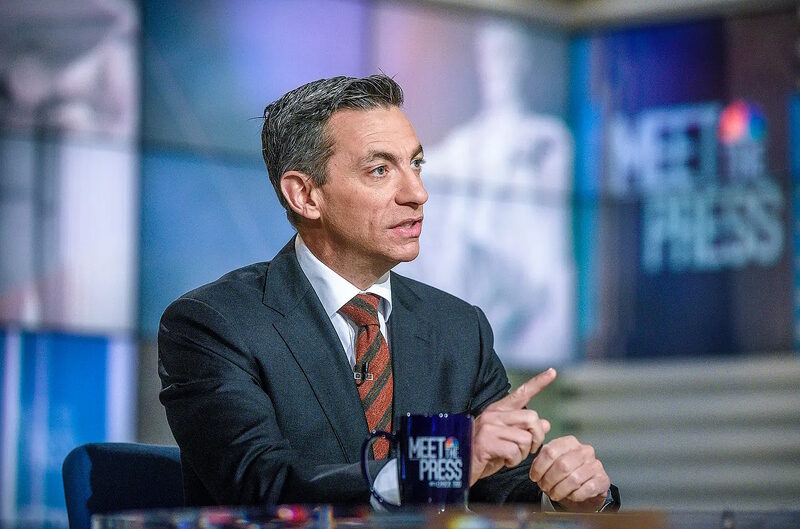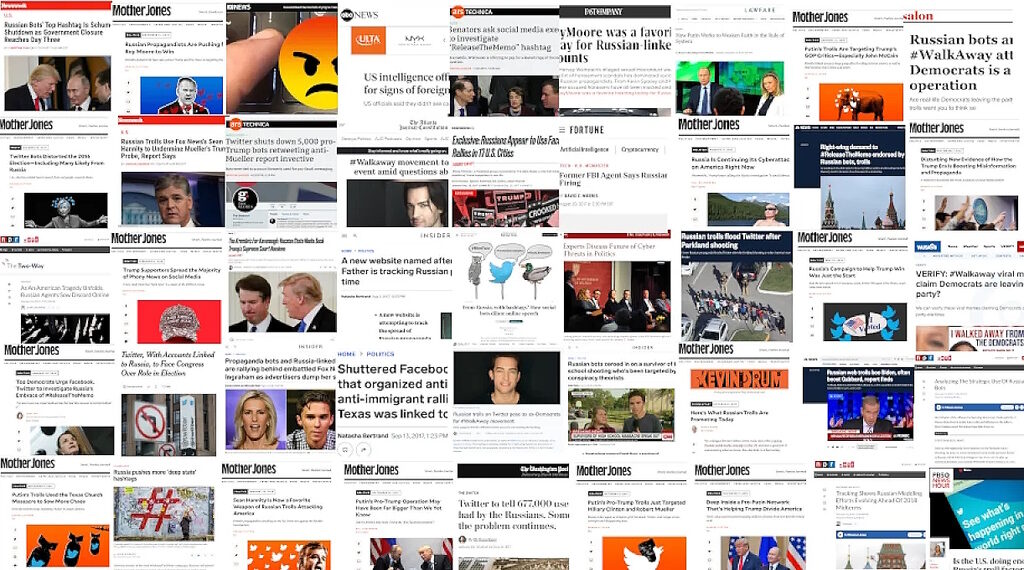
If one goes by volume alone, this oft-cited neoliberal think-tank that spawned hundreds of fraudulent headlines and TV news segments may go down as the single greatest case of media fabulism in American history. Virtually every major news organization in America is implicated, including NBC, CBS, ABC, PBS, CNN, MSNBC, The New York Times and the Washington Post. Mother Jones alone did at least 14 stories pegged to the group's "research." Even fact-checking sites like Politifact and Snopes cited Hamilton 68 as a source.
Hamilton 68 was and is a computerized "dashboard" designed to be used by reporters and academics to measure "Russian disinformation." It was the brainchild of former FBI agent (and current MSNBC "disinformation expert") Clint Watts, and backed by the German Marshall Fund and the Alliance for Securing Democracy, a bipartisan think-tank. The latter's advisory panel includes former acting CIA chief Michael Morell, former Ambassador to Russia Michael McFaul, former Hillary for America chair John Podesta, and onetime Weekly Standard editor Bill Kristol.
The Twitter Files expose Hamilton 68 as a sham:
The secret ingredient in Hamilton 68's analytic method was a list of 644 accounts supposedly linked "to Russian influence activities online." It was hidden from the public, but Twitter was in a unique position to recreate Hamilton's sample by analyzing its Application Program Interface (API) requests, which is how they first "reverse-engineered" Hamilton's list in late 2017.
The company was concerned enough about the proliferation of news stories linked to Hamilton 68 that it also ordered a forensic analysis. Note the second page below lists many of the different types of shadow-banning techniques that existed at Twitter even in 2017, buttressing the "Twitter's Secret Blacklist" thread by Bari Weiss last month. Here you see categories ranging from "Trends Blacklist" to "Search Blacklist" to "NSFW High Precision." Twitter was checking to see how many of Hamilton's accounts were spammy, phony, or bot-like. Note that out of 644 accounts, just 36 were registered in Russia, and many of those were associated with RT.
Examining further, Twitter execs were shocked. The accounts Hamilton 68 claimed were linked to "Russian influence activities online" were not only overwhelmingly English-language (86%), but mostly "legitimate people," largely in the U.S., Canada, and Britain. Grasping right away that Twitter might be implicated in a moral outrage, they wrote that these account-holders "need to know they've been unilaterally labeled Russian stooges without evidence or recourse."
Other comments in internal company emails:
"These accounts are neither strongly Russian nor strongly bots."Declared Trust and Safety chief Yoel Roth: "I think we need to just call this out on the bullshit it is."
"No evidence to support the statement that the dashboard is a finger on the pulse of Russian information ops."
"Hardly evidence of a massive influence campaign."
The two founders of Hamilton 68, the blue-and-red team of former counselor to Marco Rubio Jamie Fly and Hillary for America Foreign Policy Advisor Laura Rosenberger, told Politico they couldn't reveal the names of the accounts because "the Russians will simply shut them down." Tchya, right. One look at the list reveals the real reason they couldn't make it public.
This was not faulty science. It was a scam. Instead of tracking how "Russia" influenced American attitudes, Hamilton 68 simply collected a handful of mostly real, mostly American accounts, and described their organic conversations as Russian scheming. As Roth put it, "Virtually any conclusion drawn from [the dashboard] will take conversations in conservative circles on Twitter and accuse them of being Russian."
There were three major classes of account on the Hamilton list: a thin layer of obvious Russians (e.g. RT America), then the larger pile of real people from Western countries, followed by a percentage — somewhere between a fifth and a third — of "low user state," "near dead," "spammy" accounts that didn't accumulate followers and "do not have a very wide reach on the platform." Twitter executives observed that the zombie accounts were not amplifying the real accounts. Instead of, say, a group of Russian accounts boosting Trump messaging, it was the reverse — a bunch of real Trump accounts simulating Hamilton's assertions about Russians.
"The selection of accounts is... bizarre and seemingly quite arbitrary," wrote Roth. "They appear to strongly preference pro-Trump accounts (which they use to assert that Russia is expressing a preference for Trump... even though there's not good evidence any of them are Russian)."
Even Twitter execs were stunned to read who was listed. The names ranged from well-known media figures like David Horowitz to conservatives like Dennis Michael Lynch and progressives like Consortium editor Joe Lauria. It's crucial to understand that the list captured not just Trump supporters but a range of political dissidents, including leftists, anarchists and humorists. Wrote policy chief Nick Pickles, upon seeing the name of British satirist @Holbornlolz:
"A wind-up merchant," he wrote. "I follow him and wouldn't say he's pro-Russian... I can't even remember him tweeting about Russia."
These people never knew they were used for years to drive hundreds if not thousands of media headlines about supposed Russian bot infiltration of online discussions: about the Brett Kavanaugh hearings, Tulsi Gabbard's campaign, the #ReleaseTheMemo affair, the Parkland shooting, Donald Trump's election, the #WalkAway and #IStandWithLaura hashtags, U.S. missile strikes in Syria, the Bernie Sanders campaign, the "Blexit" movement to peel black voters away from Democrats, calls to fire National Security Advisor H.R. McMaster, "attacks" on the Mueller investigation, and countless other issues.
Last week, I began contacting people on the list. Reactions have rested between blind fury ("Motherfuckers!") and shock ("I am a 73-year-old snowbird in Florida... how could I be a Russian bot?"), with a few noting that the news was outrageous but unsurprising.
"Sadly, I'm not surprised but I am angered that we are once again falsely accused of spreading 'Russian disinformation,' this time on Twitter," said Consortium's Lauria. "Organizations like Hamilton 68 are in business to enforce an official narrative, which means excising inconvenient facts, which they call 'misinformation.'"
"I've written a book about the U.S. Constitution," says Chicago-based lawyer Dave Shestokas. "How I made a list like this is incredible to me."
"I'm listed as a foreign bot?" says Lynch. "As a proud taxpaying citizen, charitable family man, and honest son of a US Marine w/a Purple Heart, I'm hurt. I deserve better. We all do!"
As a child, Sonia Monsour lived through civil war in Lebanon, in a town that was taken over by a Christian militia. Her father counseled her then to dispose of some leftist books that they kept at home, so that her political beliefs would not be held against her. Upon being told she was on the Hamilton 68 list, she recalled that childhood story. She moved to the West to get away from such problems.
"Supposedly in a free world, we are being watched at many levels, by what we say online," she said.
Oregon native Jacob Levich (@cordeliers) was one of the few people on the list who knew what Hamilton 68 was. "I recall that it was some sort of spooky NGO that was involved in identifying accounts that were thought to be subversive," he said. Informed he was on their list, he said, "I can tell you that there is absolutely no sense in which I'm subject to any kind of Russian influence."
Levich went on:
"When I was growing up, my father told me about the McCarthyite blacklist," he said. "As a child it would never have occurred to me that this would come back, in force and broadly, and in a way designed to undermine rights we hold dear."
Levich's tale is at the heart of what is so sinister about the Hamilton 68 campaign. This was digital McCarthyism, taking people with dissident or unconventional opinions and mass-accusing them of "Un-American activities." The peculiar twist of the Hamilton 68 version of McCarthyism is that instead of targeting leftists (although there are several self-professed left-leaning accounts on the list), the bulk of the real accounts involved conservatives, with handles like ULTRA MAGA Dog Mom and @ClassyLadyForDJT.
Even at Twitter, where there were basically no open conservatives in the email record, it was recognized that Hamilton 68 (and at least two other research institutes using similar methodology) were simply taking organic Trumpish chatter and describing it as Russian scheming.
The site "falsely accuses a bunch of legitimate right-leaning accounts of being Russian bots," as Roth put it, getting "traction around partisan trends, to assert that any right-leaning content is propagated by Russian bots."
This was an academic scandal as well, as Harvard, Princeton, Temple, NYU, GWU, and other universities promoted Hamilton 68 as a source. Perhaps most embarrassingly, multiple elected officials promoted the site. Dianne Feinstein, James Lankford, Richard Blumenthal, Adam Schiff, and Mark Warner were among the offenders. Watts, who clearly knew how to play up the melodrama of his role, gave dire warnings to the Senate Intelligence Committee,telling them they should "follow the dead bodies" if they wanted to get to the bottom of the Russian interference problem.
Though it is easy to see how it could be infuriating to be put on such a list — one veteran I spoke with had to leave the room and take a deep breath before coming back to the phone — the broader damage was to society, which was subject to near-daily news reports using this "The Russian Bots Are Coming" format. These stories are still having a huge impact on American culture and politics and played significant roles in the 2018 and 2020 election cycles, placing downward pressure on the Sanders, Trump and Gabbard campaigns while boosting the likes of Joe Biden (frequently depicted as a "target" of Russian bots). In the wake of any online controversy, be it the Colin Kaepernick saga or gun control debates after mass shootings, reporters raced to claim "Russian bots" were trying to "sow division," often using Hamilton or an outfit like it to bolster their claims.
Worse, the site pioneered a new form of fake news, which reporters at organizations like Mother Jones, the Washington Post, CNN and MSNBC ate up for two reasons. One, they tended to be politically simpatico with the site's conclusions (the Daily Beast didn't need a push to claim Russian bots were pushing Trump flash mobs "in 17 cities"). Two, it was easy content.
"Here's what Russian trolls are promoting today," read a piece in Mother Jones by Kevin Drum, all but announcing that reporters could make headlines as quickly as instant coffee in the Ham68 age.
By early 2018 — perhaps after a talk with Twitter, whose execs pondered the upside of "educating Clint" — Watts was publicly questioning his own methodology, saying, "I'm not convinced on this bot thing." Not long after, another key figure associated with Hamilton 68, Jonathon Morgan of the "cyber security firm" New Knowledge, was outed for faking a Russian influence operation in the Alabama Senate Race. He used Hamilton-like tactics to create online chatter about Republican Roy Moore having Russian bot support, got caught, and suffered the indignity of having what he called a "small experiment" described as a "false flag" operation in the New York Times.
Comment: Democratic operative issues lame denial of launching false-flag anti-Russian op on Roy Moore
Even after his "experiment" was outed, and even after Watts expressed doubts about the "bot thing," the flood of "Here come the bots" news stories continued. News organizations had fallen in love with a new trick: research institute makes invented bot claims, reporters toss said claims at hated targets like Devin Nunes or Tulsi Gabbard, headlines flow. The scam needed just three elements: credentials of someone like "former FBI agent" Watts, the absence of any semblance of fact-checking, and the silence of companies like Twitter.
On the third point, Twitter is not guiltless. Though people like Roth wanted to go hard at the fabulists — "My recommendation at this stage is an ultimatum: you release the list or we do," he wrote — ultimately people like future White House and National Security Council spokeswoman Emily Horne advised caution. "We have to be careful in how much we push back on ASD publicly," she wrote. Carlos Monje, future senior advisor to Transportation Secretary Pete Buttigieg, concurred.
"I also have been very frustrated in not calling out Hamilton 68 more publicly, but understand we have to play a longer game here," Monje decided.
Even if Twitter had pushed back, it wouldn't have mattered. As it was, when company spokespeople urged reporters off the record to stay away, they didn't — just as Senators Dianne Feinstein and Richard Blumenthal didn't, when Twitter tried to warn them that "Russian bot" stories were fake. Horne wrote several times that she had no luck in steering journalists away from these hack headlines. "Reporters are chafing," she wrote, adding, "it's like shouting into a void."
I asked for comment from a huge range of actors — from the Alliance for Securing Democracy to Watts and McFaul and Podesta and Kristol to editors and news directors at MSNBC, Politico, Mother Jones, the Washington Post, Politifact, and others. Not one answered. They're all going to pretend this didn't happen. The few reporters who got this right contemporaneously, from Glenn Greenwald to Max Blumenthal to Miriam Elder and Charlie Wurzel of Buzzfeed to sites like Moon of Alabama, can take a victory lap. Almost every other news organization ran these stories and needs to come clean about it.
The Hamilton 68 tale has no clear analog in media history, which may give mainstream media writers an excuse not to cover it. They will be under heavy pressure to avoid addressing this scandal, since nearly all of them work for organizations guilty of spreading Hamilton's "bullshit" stories in volume.
This is one of the more significant Twitter Files stories. Each one of these tales explains something new about how companies like Twitter came to lose independence. In the U.S., the door was opened for agencies like the FBI and DHS to press on content moderation after Congress harangued Twitter, Facebook, and Google about Russian "interference," a phenomenon that had to be seen as an ongoing threat in order to require increased surveillance. "I do very much believe America is under attack," is how Hamilton 68 co-founder Laura Rosenberger put it, after watching the tweets of Sonya Monsour, David Horowitz, and @holbornlolz.
The Hamilton 68 story shows how the illusion of ongoing "Russian interference" worked. The magic trick was generated via a confluence of interests, between think-tanks, media, and government. Before, we could only speculate. Now we know: the "Russian threat" was, in this case at least, just a bunch of ordinary Americans, dressed up to look like a Red Menace. Jayson Blair had a hell of an imagination, but even he couldn't have come up with a scheme this obscene. Shame on every news outlet that hasn't renounced these tales.
"Outfits like Hamilton 68 don't have to agree with us," says Lauria. "But they should just leave us the hell alone."






Clint Watts another shameless Circus Barker Zionist puppet shill catapulting 💩 for the masses who haven’t figured it out still.
What/Who is German Marshall Fund [Link]
“GMF is heavily funded by the American, German, and Swedish governments. [6] Aside from governmental funding, GMF has also accepted donations from several left-of-center grantmaking organizations, including the Democracy Fund, the Charles Stewart Mott Foundation, and the Open Society Foundations. [7] Though most of GMF’s work is nonpartisan, several organization members have taken strong stances against President Donald Trump, accusing him of “imitating” Chinese aggression using “manipulation of information and bullying tactics.”
“The German Marshall Fund was founded on June 5, 1972 to commemorate the 25th Anniversary of the Marshall Plan, a Truman administration program to counter Soviet influence in postwar Western Europe with civil and military aid. [9] West German Chancellor Willy Brandt established the fund as a gift to the United States with the goal of promoting relations between the United States, Germany and the European community. [10] Then-President Richard Nixon praised the move, beginning a decades long partnership spearheaded by Harvard academic Guido Goldman , who served as the first president of the German Marshall Fund. [11]GMF worked on American policy in relation to Europe for most of the remainder of the 20th century, especially in spearheading efforts to rebuild Eastern and Central Europe and promote democracy following the fall of the Berlin Wall. [12] Today, GMF’s policy focus has expanded beyond American-European economic relations, covering all areas of policy in regions across the globe. [13] GMF has also expanded to include eight offices around the United States and Europe.”
Who is Zionist Guido Goldman son of Nahum Goldman (From an early age he became strongly allied with Zionist thought, and during World War I, while working at the Jewish division of the German Foreign Ministry, he attempted to enlist the Kaiser's support for the Zionist idea.) [Link]